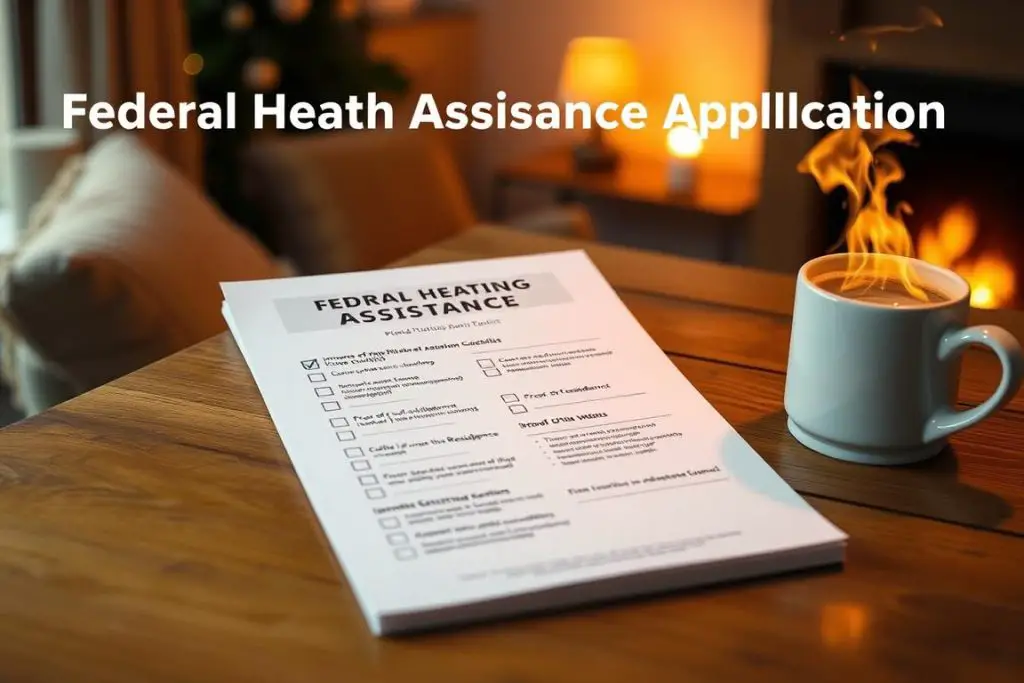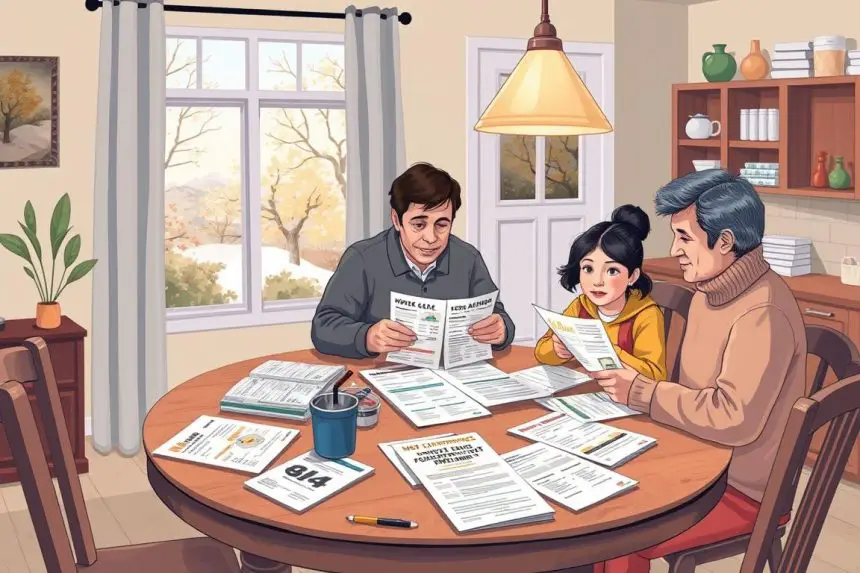Many households face a big challenge as winter arrives—dealing with high energy costs. Imagine finding a very high utility bill in your mail. This is a reality for many, showing the tough economic times we’re in. Thankfully, there’s hope through LIHEAP assistance for families in need.
LIHEAP, or Low Income Home Energy Assistance Program, is crucial. It offers utility bill financial help to those struggling. The program provides warmth and security in cold weather. It ensures families don’t have to face the cold without help.
Energy prices and living costs are always changing, making low-income energy assistance vital. It helps Americans who have to choose between heating their homes and other basic needs. If this sounds like you, learning about and getting help from LIHEAP could be a game-changer this winter.
Key Takeaways
- LIHEAP assistance is a beacon of hope for families struggling with high utility bills.
- Securing utility bill financial help is crucial for maintaining warmth and safety during cold seasons.
- Understanding LIHEAP can provide crucial support for managing heating and energy costs.
- Low-income energy assistance programs are key to helping vulnerable households.
- Now is the time to explore your options for energy assistance to ensure financial stability.
Understanding LIHEAP and Its Impact on Energy Affordability
The Low-Income Home Energy Assistance Program (LIHEAP) is crucial for many American families. It offers energy bill payment help and heating bill support. This makes energy more affordable for communities.
What is LIHEAP Assistance and Who Qualifies?
LIHEAP helps low-income families who spend much of their income on home energy. Your income must be below a certain level to qualify. Household size and energy costs also matter. It’s best to apply early and learn about the LIHEAP application process. For more details, visit the official LEAP page.
Examining the Benefits of Low-Income Energy Assistance
LIHEAP offers more than just help with energy bills. It also leads to savings through weatherization and minor home repairs. It’s important to remember, LIHEAP benefits are given out seasonally and are meant to be temporary.
- Reduction in energy expenditure
- Prevention of service disconnections during peak usage
- Improvement in overall home energy efficiency
| Service | Description | Impact |
|---|---|---|
| Financial Assistance | Direct aid to cover energy bills | Immediate financial relief |
| Energy Crisis Assistance | Support during emergencies like utility cutoffs | Critical intervention to maintain energy supply |
| Heating Equipment Repair | Fixing or replacing heating units | Ensures a safe, warm home environment |
Real Stories: How LIHEAP Has Helped Families Manage Energy Costs
Many have shared how LIHEAP lessened their financial burden in winter. It also prevented utility shutoffs, keeping families with children or elderly members safe and warm.
“Thanks to LIHEAP, my family could afford our heating bills and stay warm all winter. It was a huge relief during a tough time,” shared a grateful beneficiary. These stories highlight LIHEAP’s importance in helping American families.
Navigating the Application Process for Federal Heating Assistance
Are you struggling with high utility bills? Applying for federal heating assistance like the Low Income Home Energy Assistance Program (LIHEAP) can help. This guide makes understanding how to get energy cost aid easier.
- Assess Your Eligibility: Your household income must be below a specific level to qualify for utility assistance programs. These levels change based on where you live and the size of your family.
- Gather Necessary Documentation: Collect recent utility bills, income proof, a photo ID, and Social Security cards for everyone in your home.
- Complete the Application: You can apply online, by mail, or in person at community agencies.
- Submit Before Deadlines: Know your state’s application period for federal heating assistance to avoid missing out.
Here’s some advice from those who’ve been successful:
- Apply as early as possible to get aid before the money runs out.
- Make sure your application is correct to prevent delays.
- If you’re having trouble, get in touch with your local LIHEAP office for help.
State-Specific Variations: Different states have unique requirements. Check with your state’s utility assistance program office for details.
LIHEAP’s goal is not only to help you with bills. It aims to keep your home safe and warm in bad weather. Getting through the application process successfully means getting vital help with energy costs.

These steps can help make applying for federal heating assistance easier. It can make the challenge of affording winter heating costs less overwhelming.
Conclusion
LIHEAP assistance is more than help. It’s essential for low-income families facing high energy costs. This program is key in keeping homes safe and healthy. It makes sure basic utilities are affordable for those in need.
Seeing low income energy assistance as just a luxury is wrong. It’s a critical shield against financial hardship. If you qualify, applying for LIHEAP can be a lifesaving move. It gives you peace, knowing your family will stay warm in winter and cool in summer.
Don’t wait to seek help. If you need it, take steps now. Collect your financial records and reach out. This isn’t just about getting through the month. It’s about building a stable future. Learn more about LIHEAP and how it can help. Taking time to apply for LIHEAP assistance is a step towards a secure future for your family.
FAQ
What exactly is LIHEAP assistance and who is eligible for this program?
LIHEAP stands for Low Income Home Energy Assistance Program. It’s a federal plan to help low-income families pay their energy bills. You might be eligible if your income is below a certain level, which depends on where you live and your family size. This program is a big help for those who find it hard to afford heating and utility costs.
How can LIHEAP support families facing high energy costs?
LIHEAP helps by paying part of your energy bills. It can also help if you’re in an energy crisis, make your house more energy-efficient, and even fund small home repairs related to energy. This assistance means you won’t have to choose between staying warm and other basics. The program makes sure low-income families stay safe and healthy by keeping their utilities on.
What kinds of benefits can I expect from low-income energy assistance programs like LIHEAP?
LIHEAP can offer you a one-time payment to help with heating or cooling costs. If you’re close to having your utilities cut off, it can provide emergency help. It also funds weatherization to save energy and money in the long run. The goal is to lessen the pressure of high energy bills on low-income people.
Are there real stories of how LIHEAP has helped individuals or families manage their energy costs?
Yes, many individuals and families have seen big changes thanks to LIHEAP. They share stories of how they avoided utility shut-offs during harsh weather, made their homes more efficient, and found relief from financial stress. These stories highlight the program’s impact in preventing tough choices between heating and essential needs like food and medicine.
What is the application process for federal heating assistance through LIHEAP?
To apply for LIHEAP, you need to fill out an application. This can often be done online, by mail, or in person. You must provide proof of income, how many people live in your house, and where you live. You’ll also need your most recent utility bills. Make sure to apply early as funds are given out first-come-first-served. Check with your local LIHEAP office for more details.
Can I apply for LIHEAP assistance at any time of the year?
No, LIHEAP has set times for applying which differ by state. Knowing your state’s enrollment times is crucial, so apply as soon as it opens. In emergencies, some places offer help all year. If you’re in a crisis when it’s not enrollment time, check if you can get emergency help.
How long does it take to receive LIHEAP assistance after applying?
Getting LIHEAP help can take a few weeks as your application is processed. But if you’re facing an emergency, like a shut-off, there may be faster help. Keep your documents organized to help speed things up.
What should I do if my LIHEAP application is denied?
If LIHEAP turns you down, you can ask for a review of the decision. You will get details on why and how to appeal. Be quick to provide any extra info needed and contact your local LIHEAP for help with the appeal. Also, look for other help in your community that might work for you.
Where can I find more information about the LIHEAP application process or other utility assistance programs?
For more on LIHEAP and other help, visit the U.S. Department of Health & Human Services website. Your local LIHEAP office has info too. Many states have their own programs with specific details on how to apply and when.
Are energy cost aid and utility bill financial help only for heating or do they cover other utilities as well?
LIHEAP is known for heating help, but it also assists with cooling in some places. Plus, it offers weatherization help and small repairs for energy reasons. Its goal is to ensure safe, healthy living conditions for low-income households no matter the utility challenge.




